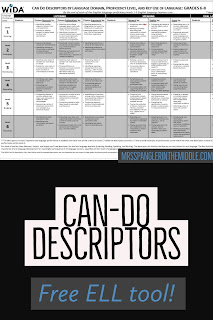I teach 7th grade Language Arts and have a class of 22 students who speak Spanish and Portuguese as their first language. They are all together in my sheltered ELA class. That means that while it is a regular class for students to learn how to USE English (and not how to SPEAK English), there are more strategies, interventions and scaffolding present.
What strategies and interventions you ask?
Here is my Top 10 List:
10. Can-Do Descriptors
These come from WIDA - "WIDA advances academic language development and academic achievement for children and youth who are culturally and linguistically diverse through high quality standards, assessments, research, and professional learning for educators."
These free "Can-Do Descriptors" give teachers a list of things students can do in the classroom based on their level of proficiency. What I found helpful is that it gives me an idea of what I can ask these students to do even though I am supposed to teach them the same standards as the rest of the 7th grade.
9. Giving out discussion questions a day early.
I really want all my students to practice speaking in class but I know they need time to think and process what they want to say in English. So, I give them the discussion questions the day before I want to actually discuss.
8. Classifying/Categorizing
This is a great word sort activity that can be used to scaffold any text or concept. Since I have to teach essay writing to students who have no concept of what an essay even is, I will be using this concept very soon.
7. Communication Games
Games like "I have____, who has____" help students practice their English and the concepts at the same time.
 |
| Source |
I also enjoy standing or sitting in a community circle and asking the students to say hello to the person next to them using their name and then giving a word to describe our unit.
(I change this up with other "words of the day" like a word to describe how they feel that day, or a word about our unit, or a new word that they have learned.)
6. Centers/Learning Stations
These help me make sure that my multi-level students each get something that either isn't too hard or too boring. I have students who range from speaking absolutely no English to those that are on their way out of ESOL. Centers allow me to tailor activities to the level of the student.
5. Chart Progress
I have experimented with a Super Improvers board from Whole Brain Teaching and have had some good success with it. The focus is on progress, not perfection and when a student is able to show progress, they earn a point towards moving up a level. Each level has certain privileges tied to it. I ask the students what privileges they would like to earn and then set the levels. This year, I have been keeping track of points by using Class Dojo.
The students like to see that they are making progress and it helps to motivate them.
4. Whole Brain Teaching Gestures
 |
| Source |
Whole Brain Teaching gives you non-verbal hand gestures to use to teach various concepts including the ones pictured above. I have even made some of my own! They are great for engaging students in an action and helping them remember important ideas!
3. Cloze reading passages
We're reading Tangerine by Edward Bloor in 7th grade. All students have to take the same tests, so even my ESOL students must take these tests even if they are struuuuggggling to read the book. So what did I do? I made Cloze reading passages:
As you can see, Cloze reading passages just leave out key words for the students to fill in. I actually included a word bank too. This worked really well for my students but the research also says that it helps poor readers:
I also use a lot of sentence frames which are similar to cloze passages to help my students with their writing too.
 | |||
| Source
2. Graphic Organizers
I try to use graphic organizers for just about every concept I teach in my ESOL class. The more visual I can
|
1. Pictures
Ok, this seems obvious because we all know that when students can correlate a picture to a word/concept, they can remember it much better.
So building on this, I have made it so that most things I present in my ELA class (reading and writing skills) have pictures that accompany any words that go on my Word Wall:
 |
| Get a free set of these cards by clicking here! |
Plus, I have incorporated these same pictures into my own brand of notes called Pixanotes:
These notes have four differentiation options:
1. Fully printed content and pictures. (Students highlight key words.)
2. Fully printed content and picture flaps (Students highlight key words and match up pictures.)
3. Fill-in-the-blanks content and fully printed pictures. (Students use a word bank.)
4. Fill-in-the-blanks content and picture flaps. (Students use a word bank and match up pictures.)
Try a sample for free by clicking the image below!
You can also see them in action here:
Some days teaching a full class of non-English speakers seems daunting, but this list actually helps me remember the things I can do and I hope it helps you too!
Thanks for stopping by!






